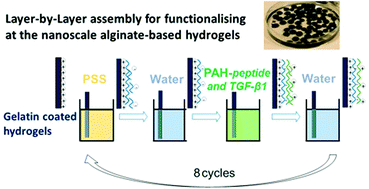当前位置:
X-MOL 学术
›
Biomater. Sci.
›
论文详情
Our official English website, www.x-mol.net, welcomes your feedback! (Note: you will need to create a separate account there.)
Alginate-based hydrogels functionalised at the nanoscale using layer-by-layer assembly for potential cartilage repair
Biomaterials Science ( IF 6.6 ) Pub Date : 2017-07-18 00:00:00 , DOI: 10.1039/c7bm00525c P. Gentile 1, 2, 3, 4 , C. Ghione 5, 6, 7, 8, 9 , A. M. Ferreira 1, 2, 3, 4 , A. Crawford 4, 9, 10, 11 , P. V. Hatton 4, 9, 10, 11
Biomaterials Science ( IF 6.6 ) Pub Date : 2017-07-18 00:00:00 , DOI: 10.1039/c7bm00525c P. Gentile 1, 2, 3, 4 , C. Ghione 5, 6, 7, 8, 9 , A. M. Ferreira 1, 2, 3, 4 , A. Crawford 4, 9, 10, 11 , P. V. Hatton 4, 9, 10, 11
Affiliation

|
Injuries to articular cartilage are frequently difficult to repair, in part because of the poor regenerative capacity of this tissue. To date, no successful system for complete regeneration of the most challenging cartilage defects has been demonstrated. The aim of this work was to develop functionalised hydrogels at the nanoscale by Layer-by-Layer (LbL) assembly to promote cartilage healing. Hydrogels, based on sodium alginate (NaAlg) and gelatin (G), were prepared by an external gelation method consisting of CaCl2 diffusion and genipin addition for G crosslinking. Successively, hydrogels were coated with G to obtain a positive charge on the surface, then functionalised by LbL assembly to create 16 nanolayers, based on poly(styrene sulfonate)/poly(allyl amine) (PSS/PAH), including a specific peptide sequence (CTATVHL) and transforming growth factors β1 (TGF-β1). Physico-chemical properties were evaluated by XPS, ATR-FTIR and rheological analyses while in vitro cytocompatibility was studied using bovine articular chondrocytes (BAC). XPS spectra showed N1s and S2p peaks, indicating that PAH and PSS have been introduced with success. ATR-FTIR indicated the specific PAH and PSS absorption peaks. Finally, the biomolecule incorporation influenced positively the processes of BAC adhesion and proliferation, and glycosamynoglycan secretion. The functionalised alginate-based hydrogels described here are ideally suited to chondral regeneration in terms of their integrity, stability, and cytocompatibility.
中文翻译:

基于藻酸盐的水凝胶在纳米尺度上使用逐层组装进行潜在的软骨修复
关节软骨损伤通常很难修复,部分原因是该组织的再生能力差。迄今为止,还没有成功的系统可以完全再生最具挑战性的软骨缺陷。这项工作的目的是通过逐层组装(LbL)组装来开发纳米级的功能化水凝胶,以促进软骨愈合。基于藻酸钠(NaAlg)和明胶(G)的水凝胶是通过由CaCl 2组成的外部凝胶化方法制备的扩散和京尼平添加,用于G交联。随后,将水凝胶涂上G以获得表面上的正电荷,然后通过LbL组装功能化以基于聚(苯乙烯磺酸盐)/聚(烯丙基胺)(PSS / PAH)形成16个纳米层,包括特定的肽序列(CTATVHL)和转化生长因子β1(TGF-β1)。通过XPS,ATR-FTIR和流变分析评估理化性质,同时使用牛关节软骨细胞(BAC)研究体外细胞相容性。XPS光谱显示N 1s和S 2p峰,表明成功引入了PAH和PSS。ATR-FTIR指示了特定的PAH和PSS吸收峰。最后,生物分子的掺入对BAC黏附和增殖以及糖胺聚糖的分泌过程产生了积极的影响。就其完整性,稳定性和细胞相容性而言,此处所述的功能化藻酸盐基水凝胶非常适合软骨再生。
更新日期:2017-08-03
中文翻译:

基于藻酸盐的水凝胶在纳米尺度上使用逐层组装进行潜在的软骨修复
关节软骨损伤通常很难修复,部分原因是该组织的再生能力差。迄今为止,还没有成功的系统可以完全再生最具挑战性的软骨缺陷。这项工作的目的是通过逐层组装(LbL)组装来开发纳米级的功能化水凝胶,以促进软骨愈合。基于藻酸钠(NaAlg)和明胶(G)的水凝胶是通过由CaCl 2组成的外部凝胶化方法制备的扩散和京尼平添加,用于G交联。随后,将水凝胶涂上G以获得表面上的正电荷,然后通过LbL组装功能化以基于聚(苯乙烯磺酸盐)/聚(烯丙基胺)(PSS / PAH)形成16个纳米层,包括特定的肽序列(CTATVHL)和转化生长因子β1(TGF-β1)。通过XPS,ATR-FTIR和流变分析评估理化性质,同时使用牛关节软骨细胞(BAC)研究体外细胞相容性。XPS光谱显示N 1s和S 2p峰,表明成功引入了PAH和PSS。ATR-FTIR指示了特定的PAH和PSS吸收峰。最后,生物分子的掺入对BAC黏附和增殖以及糖胺聚糖的分泌过程产生了积极的影响。就其完整性,稳定性和细胞相容性而言,此处所述的功能化藻酸盐基水凝胶非常适合软骨再生。



























 京公网安备 11010802027423号
京公网安备 11010802027423号